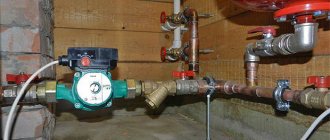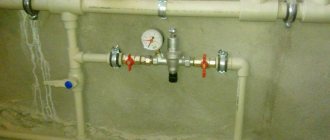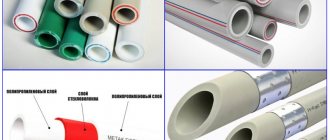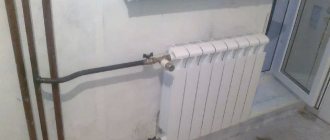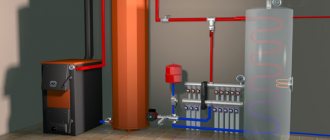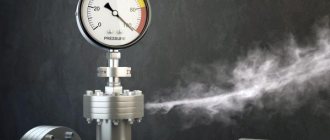Water heating in a modern home is a complex system that must work reliably and uninterruptedly. However, there are a number of reasons why a failure occurs, such as installation errors, equipment wear and tear over time, etc. All these factors can affect the tightness of the circuits and cause malfunctions. To find the damaged area, a pressure test of the entire water heating system is required. How is this manipulation performed in a private (country) house and is it possible to do it with your own strength and hands? What level of pressure should it be? You can read about all this and watch the video.
Pressure testing - what is it?
Pressure testing of a finished water heating system is a test of tightness and assembly quality.
Whether the system can be put into operation or not depends entirely on the results of such a check. This is the first procedure that needs to be carried out after installation and before turning on the heating. At its core, it is control without destruction. Air or water is pumped into the system, thereby creating increased pressure. If there are no leaks, you can safely put the system into operation.
Pressure testing is also carried out when checking an already operating system. After all, leaks often appear at the places where parts are connected using fittings, soldering or welding. The pipes themselves may also suffer, for example, from mechanical stress or corrosion. High temperature and pressure also cause gradual wear of pipes and parts of the water heating system. To detect and eliminate the location of the flaw, crimping is required.
This is a set of measures through which not only the heating system, but also the hot water supply, sewage system, and pipes in the water well can be checked in a private home.
Pressure testing of a heated floor system
The crimping procedure includes:
- pipeline testing and flushing;
- checking and, if necessary, replacing parts;
- restoration of damaged insulation.
The following are tested under high pressure:
- strength of housings, as well as walls of pipes, radiators, heat exchangers and fittings;
- fastening when connecting the elements that make up the system;
- maintenance of taps, pressure gauges, as well as gate valves.
Equipment and test frequency
Pressure testing of centralized systems is carried out by personnel using standard equipment, so it is hardly worth talking about. But not everyone probably knows about the costs of private heating and water supply. These are special pumps. There are two types - manual and electric (automatic). Manual pressure testing pumps are autonomous, the pressure is pumped up using a lever, and the created pressure is controlled using a pressure gauge built into the device. Such pumps can be used for small systems - pumping is quite difficult.
Manual crimping machine
Electric pumps for pressure testing are more complex and expensive equipment. They usually have the ability to create a certain pressure. It is set by the operator, and it is “caught up” automatically. Such equipment is purchased by companies engaged in professional crimping.
According to SNiP, hydraulic testing of heating systems must be carried out annually, before the start of the heating season. This applies to private houses too, but few people comply with this standard. At best, they check it once every 5-7 years. If you are not going to test your heating annually, then there is no point in buying a pressure tester. The cheapest manual one costs about $150, and a good one costs from $250. In principle, you can rent it (usually from companies that sell components for heating systems or from offices that rent equipment). The amount will be small - you need the device for several hours. So this is a good solution.
Existing methods for pressure testing a heating system
Pressure testing with water . With this method, a hose running from the water supply is connected to a tap located on the collector or boiler. After filling the system with water, the pressure level should reach operating figures - 1.5 atm.
Pressure testing with air . With this method, a pressure tester is connected to the system - a compressor that pumps air. The pressure in the area being tested should become greater than the working pressure, which is usually 1.5 - 2 atm. In this case, an adapter is installed in place of the Mayevsky tap, designed to connect a compressor.
Advice. In order not to specifically purchase an expensive pressure tester, when carrying out independent work to check a small area, you can use a car pump with a pressure gauge.
Air pressure testing is carried out when it is not possible to connect to a water supply system, as well as in winter, when there is a possibility of water remaining in the pipes with subsequent freezing. When working with air, the integrity of the system is determined using pressure gauge readings. If the discharge pressure is kept at the same level, there are no leaks. To visually detect fistulas, a soap solution is applied to the suspected areas.
Pressure test pump for heating system
Test Tools
To test the system for resistance to high pressure, a special device is used, which is called a pressure tester. It is a pump capable of creating pressure inside the system up to 60 or 100 atmospheres, depending on the type of mechanism. There are 2 types of pumps: manual and automatic. They differ only in that the second option stops pumping itself if the pressure reaches the desired level.
The pump consists of a tank into which water is poured and a plunger pump with a handle that moves it. On the body of the mechanism there are taps to block the pressure supply and pressure gauges to regulate the pressure. There is also a tap on the tank that allows you to drain the water that remains in the tank.
The principle of operation of such a pump is similar to a conventional piston analogue, which is used to inflate tires. The main difference is the cylindrical piston made of steel. It is fitted tightly inside the housing and a minimum gap is created, which makes it possible to pump up pressure up to 60 atmospheres.
Manual blower Source amazon.com
For hand pumps, the biggest disadvantage is that such pressure testing of pipes will take a very long time due to pumping the system with water. This process can take several hours, since large systems that have radiators will need to be filled manually.
Automatic devices work on a similar principle, but when the pressure limit is reached, they turn off themselves. They also require electricity to operate, so manual ones are more suitable for places where there is no power supply yet. Automatic pumps can pump pressure up to 100 bar, and industrial devices up to 1000 bar.
Electric version of the compressor Source ngenix.net
See also: Catalog of house projects with a boiler room up to 1 million rubles
How does the crimping process work?
- Preparing the system before pressure testing. If the system is autonomous, then the heat generator is turned off first. If not, then taps are used to close off the area where inspection is required. The coolant must be drained.
- The system circuit is filled with water having a temperature of no higher than 45 C. The air is gradually released.
- The compressor is connected and air begins to flow into the pipes.
- At the beginning of the procedure, the pressure is brought to the working level and the area is visually inspected for violations. Then the pressure is gradually increased to the test level - this is maintained for at least 10 minutes.
- The area or the entire system is inspected for leaks at the connections. It is mandatory to visually inspect fittings, radiators and the entire length of pipe walls for fistulas. If deviations are detected, all defects and shifts are recorded. The operation of taps and valves is checked.
- Using pressure gauge readings, the drop in pressure level is determined. If it has not decreased, the system is in normal operating condition.
- Based on the results of the inspection, a report is drawn up.
Video description
This video shows why pressure testing of the system is necessary.
To carry out the work, water with a temperature of 42 °C is poured into the heating circuit and air is released through special valves. Within 10 minutes, a test pressure is created, with which the joints are checked for leaks. After this, the pressure is increased to the required standard and a test is carried out for 10 to 30 minutes, depending on the material from which the system is made.
On private plots, the test can be carried out no more often than once every 4-5 years. To do this, you do not need to have a lot of knowledge and skills, and the entire procedure can be done independently, if you have the necessary equipment. In order not to spend a lot of money on purchase, you should rent a compressor or call a special service to check the pipes.
Checking pressure by a specialist Source inkrasnogorsk.ru
In a high-rise building
Pressure testing of heating pipes in multi-storey buildings is most often done in the middle or end of spring, after the heating is turned off. If complaints are received about low water temperature, then the heating company must carry out a calculation of the radiators. Under certain conditions, they can be replaced, removed or new ones added. During the inspection, all risers are checked for blockages and washed under high pressure along with the rest of the system.
Also, during inspections, insulating gaskets, seals on cast iron valves and stuck bolts should be changed. During this, the fittings in elevators and pipes are inspected. This is to check them for rust or damage. After all the tests, the condition of the heat-insulating materials on the line is analyzed.
At the end of the checks, it is necessary to carry out pressure testing of the pipes, taking into account the material from which the system is made and the operating pressure of the system. If the pipes are made of cast iron, then the pressure does not rise above 6 atmospheres, and if they are in the walls - no more than 10 bar, as with panel heating systems.
Example of cast iron radiators Source radiator-home.ru
See also: Catalog of companies that specialize in heating, water supply, sewerage and lighting
Pipe inspection is done in 2 steps. To do this, first the entire heating system is checked, and then its individual sections are tested under higher pressure. To do this, the heating circuit is filled with water, which has a low pH level, which avoids the formation of deposits on the pipes. The pressure is increased using electric pumps, since it is often impossible to manually fill such a volume.
If the pressure has not dropped within 30 minutes, then pressure testing can be completed. If there is a leak, it must be found and removed, and then the test must be repeated. Each node is individually checked in a similar way, only the pressure is increased to 10 atmospheres.
Pressure in pipes during crimping process
The test pressure level, as recommended by building codes and regulations (SNiP), should be 1.5 times higher than the working pressure, but not lower than 0.6 MPa. According to the rules of technical operation of heating networks - 1.25 times higher than the working one and not lower than 0.2 MPa.
In a private house with up to three floors, the pressure usually does not exceed 2 atm. When it is exceeded, a special valve is activated and a reset occurs. In five-story buildings the pressure is 3-6 atm; in buildings from 8 floors - 7-10 atm. The maximum test pressure level depends on the characteristics of the constituent elements of the system: pipes, radiators, fittings, etc.
About wiring diagrams
The simplest heating wiring diagram is considered to be a single-pipe one.
Its features:
- There is 1 circuit (closed in a ring);
- All radiators are connected in series;
- The coolant circulates in a closed circuit.
This is one of the simplest designs. But there are significant drawbacks here too. Thus, a single-pipe system is not suitable for large multi-story buildings. Since the further away the radiator is, the weaker it heats up. This means that the rooms will warm up unevenly.
And increasing the number of sections on a separate battery will not solve the problem. It’s just that the coolant tends to cool down along the way. And the last radiator in the line will be colder than the previous ones.
Therefore, it is worth installing a single-pipe system only in houses with a small area. You can compensate for this moment using a forced circulation pump. The changes are obvious:
- Pumping equipment is connected to the boiler;
- The coolant begins to circulate through the system with acceleration;
- The temperature will not change and all radiators will heat up correctly.
And at the same time, there are several disadvantages:
- Purchasing a pump is an expense;
- The equipment requires power supply;
- If there is a power outage, the heating will stop working.
Crimping: how to do it yourself
Often, when building a private house, the heating system is installed before the water is connected. Therefore, a large water container and a submersible pump are used to pump water into the pipes. During the manipulation, you need to constantly monitor the pressure using a pressure gauge and control the water level in the container, gradually adding it if necessary.
Checking the heating system before starting
When the pressure readings rise to 2-2.5 atm, the pump is turned off, and the remaining air is gradually released from the system using Mayevsky taps. Further, after the mark on the pressure gauge drops below 1 atm, filling with water continues. This is done until the water completely displaces the air and the pressure reaches a level of 1.2-1.5 atm.
If no leaks are detected, you can connect the boiler and start the system.
Advice. To perform the procedure yourself, inexpensive submersible pumps are suitable, and you can easily adapt a barrel, bucket or basin as a water container.
For such an important event as crimping, it is better to hire a team that has the appropriate license. These people are fully responsible for the actions performed. In this case, the customer receives all the necessary documents about the work performed.
Attention! The report on the pressure testing carried out must include the time during which the system was under test pressure and indicate its level.
Pressure testing of a heating system is a matter that requires a serious approach. This operation should be carried out with your own hands only in extreme cases.
Non-standard methods
Elevator without nozzle
How and with what to flush the heating system of an apartment building in the absence of a compressor and a control campaign?
Unfortunately, this also happens far from large cities. In this case, running the elevator unit without a nozzle for two to three days often helps. When the inlet, house and domestic hot water valves are turned off, the water-jet elevator is removed, the nozzle is removed from it, and the suction (the bottom flange of the elevator) is muffled with a steel pancake.
The water jet elevator has been removed and the suction has been turned off. Water from the supply line of the heating main goes directly into the heating outlet.
- The temperature of the coolant in the heating circuit increases;
- Circulation accelerates. The nozzle no longer restricts the flow of water from the supply thread of the heating main. The difference between the beginning and end of the circuit is not the standard 0.2 kgf/cm2, but 2-3 atmospheres.
Pressure distribution in the elevator unit. It is explained by the operating principle of the water jet elevator (right).
Why is this procedure abnormal? Because in this mode:
- Heat consumption increases many times (that is, its supplier incurs losses);
- The temperature regime of the heating main operation is disrupted. Excessively hot water enters the return line. Due to the technological cycle of the CHP plant, before a new circulation cycle, it has to be cooled to the required temperature.
Flushing tap
How to rinse the battery yourself if the efficiency of the heating device has noticeably dropped over several years of operation?
To begin with, in the summer, before the start of the heating season, it needs to be equipped with a flushing tap.
The blind plug of any modern radiator can easily be converted into a pass-through plug, ready for installation of a flusher. Just unscrew the plug.
The best flusher is a ball valve with male-female threads (external and internal), screwed into the radiator cap.
Inexpensive and reliable washer.
After starting the heating, a regular garden hose is connected to the flushing tap, clamped with a clamp on a pipe with a short 1/2-inch thread. The hose is directed into the sewer - into the toilet or into the bathtub outlet. As soon as you open the tap, the sludge accumulated in the outer sections will fly out at the front of the water flow.
Earthenware is afraid of temperature changes. Therefore, it is better to insert the hose into the toilet as deep as possible, so that hot water flows directly into the riser;
If the toilet bowl, into which hot water is discharged during flushing, heats up quickly, it may crack.
- Secure the hose. Otherwise, you risk conducting an unplanned experiment illustrating jet propulsion. Considering that the role of the jet stream will be played by hot and very dirty water, the result will not please you;
- Wait for the water to clear. While dirt is being discharged, continue flushing.
Why did I classify this washing method as non-standard? You see, the operating rules for closed heating systems prohibit the withdrawal of water from the heating system. In open systems, a reset is in principle possible, but in our case it goes past the water meter and again leads to the consumption of unpaid hot water.
All consumed water must pass through metering devices.
Flushing is only necessary for radiators with lateral or diagonal connections. The more sections there are, the faster the last of them become clogged with dirt. With a two-way bottom connection, continuous circulation through the bottom corrector of the device prevents it from silting.
Lateral one-way connection of 10 sections is a guaranteed deposit of silt.
Two-way bottom connection. The lower collector is constantly flushed with coolant.
Rating of quality crimpers for 2021
Our top list is compiled based on real reviews, it takes into account the opinions of customers familiar with the product, its functions, and features. Here you will find photos and tables of characteristics.
Inexpensive
Zitrek TH-25
The Zitrek TH-25 hand-held device is a high-precision plumbing tool used for hydrodynamic testing of pipeline structures and communications services. "Zitrek TH-25" is used for certification of equipment after installation and repair work in the construction and housing and communal services sector.
The device is capable of pumping water, antifreeze, oil. The device kit includes: pressure gauge, sleeve. "Zitrek TH-25" is used as a hydraulic mechanism as part of more complex units.
Technical indicators:
ParametersCharacteristics
| Maximum fluid temperature | 80 °C |
| Volume of the tank | 5 l |
| Type | Manual |
| View | Specialized work |
| Test pressure | 30 bar |
| Connection to pipeline | External G1/2 |
| Working fluid | Water, oil |
| Rotor | Dry |
| Weight | 3 kg |
| Dimensions | 320x200x260 mm |
| Permissible fluid temperature | from +5 to +80 °С |
| Series | T.H. |
| Weight of packaged goods, kg | 1.99 |
| Dimensions of packaged goods, mm | 321 x 192 x 122 |
Zitrek TH-25Advantages:
- designed to increase pressure in pipelines (functions only as a testing tool to check for leaks);
- pressure gauge;
- small dimensions, weight;
- comfortable handle;
- can act as a hydraulic drive for various devices.
Flaws:
- not detected.
HSY30-5
The HSY30-5 testing device is capable of quickly and fairly accurately testing the tightness of sewers, pipelines, and other closed circuits. The mechanism is suitable for servicing solar batteries. Constant pressure is generated thanks to the reliable design of the device. It includes an ergonomic valve that regulates the opening of the valves, a brass piston and a casing.
Due to the filter located at the inlet, the HSY30-5 is protected from damage caused by dirt entering the system. The mechanism is distinguished by its small dimensions and mobility; the manual drive allows you to avoid searching for a power source at the construction site. The set is complemented by a metal container with anti-corrosion coating.
Technical indicators:
ParametersCharacteristics
| Volume of the tank | 12 l |
| Type | Manual |
| Test pressure | 60 bar |
| Connection to pipeline | External G1/2 |
| Working fluid | Water |
| Rotor | Dry |
| Weight | 7.8 kg |
| Dimensions | 500x190x140 mm |
| Series | HSY |
| Housing material | Steel |
| Product unit | Thing |
| Weight of packaged goods, kg | 7.5 |
| Dimensions of packaged goods, mm | 520 x 200 x 310 |
HSY30-5Advantages:
- pressure gauge data is read while the equipment is operating;
- brass piston and valve body ensure long service life;
- efficiency 45 ml/cycle;
- compact, lightweight, ideal for mobile use;
- unique valve system maintains constant pressure
- The input filter increases operational reliability.
Flaws:
- not detected.
Rotor Test Mini
The hand-held tester “Rotor Test Mini” is used to test the tightness of water-carrying communications with a pressure of up to 25 bar; the device has a metal tank with a capacity of 5 liters. The device is able to quickly “pressure test” the heating system. "Rotor Test Mini" is used for testing leaks inside air circuits, refrigerators, oil and sprinkler structures, and other closed installations. The pressure gauge included in the kit is easy to read. The holder has a rubber pad that allows you to carry the device more comfortably.
Technical indicators:
ParametersCharacteristics
| Max liquid temperature | 60 °C |
| Volume of the tank | 5 l |
| Type | Manual |
| Test pressure | 25 bar |
| Connection to pipeline | External G1/2 |
| Working fluid | Water |
| Rotor | Dry |
| Weight | 7 kg |
| Dimensions | 320x210x260 mm |
| Permissible fluid temperature | from +5 to +60 °С |
| Housing material | Steel |
| Weight of packaged goods, kg | 3 |
| Dimensions of packaged goods, mm | 32 x 21 x 26 |
Rotor Test MiniAdvantages:
- compactness;
- metal casing (reservoir);
- comfortable rubberized handle;
- high-precision pressure gauge that controls parameters;
- The piston is made of strong brass that is resistant to corrosion.
Flaws:
- not detected.
Average
Rothenberger RP 50
The manual German unit “Rothenberger RP 50” is used for accurate, quick testing of working pressure, tightness of water supply structures, tanks, heating and plumbing equipment, compressors, steam, cooling, and oil units. The device generates pressure in the test space, after which the operator closes the shut-off valve and observes whether the pressure gauge readings drop. This is how it is determined whether the water supply structure or container is airtight.
Constant pressure inside the unit is ensured thanks to 2 valves and stainless steel ball spindles. "Rothenberger RP 50" has a reliable tank with a capacity of 12 liters made of galvanized sheet steel, which can successfully withstand mechanical damage, harmful environmental influences, freezing, and does not rust. The machine has a metal piston, a 0-60 bar pressure gauge, and the set includes a connecting fitting with a 0.5-inch nut.
Technical indicators:
ParametersCharacteristics
| Max liquid temperature | 50 °C |
| Volume of the tank | 12 l |
| Performance | 0.045 l/min |
| Type | Manual |
| Test pressure | 60 bar |
| Connection to pipeline | Internal G1/2 |
| Working fluid | Water, oil |
| Rotor | Dry |
| Weight | 8 kg |
| Dimensions | 720x170x260 mm |
| Permissible fluid temperature | 50 °C |
| Series | RP 50S |
| Housing material | Steel |
| Weight of packaged goods, kg | 7.91 |
| Dimensions of packaged goods, mm | 535 x 195 x 357 |
Rothenberger RP 50Advantages:
- meets the high requirements of German quality workmanship;
- icing resistance;
- wear resistance;
- tank volume 12 l;
- consumption about 45 ml/cycle;
- connector R 1/2”;
- control hose with fabric braid;
- reduced risk of measurement errors due to the quality of the hose;
- the ability to use a pressure gauge with a precise scale (0.1 bar) for testing up to 16 bar;
- high performance;
- fast filling with long stroke;
- ergonomic handle;
- The pressure gauge needle accurately indicates the set pressure, so the pressure drop is easy to determine.
Flaws:
- not detected.
NR-60
The manual testing device “NR-60” was manufactured by a Russian company; the device is equipped with a container and is used to test the tightness of pipes and tanks. The unit can withstand pressure up to 60 bar (6 MPa). “NR-60” is a multi-tasking instrument; its measuring instruments are located conveniently for the operator monitoring the readings of the main parameters.
The casing of the device is resistant to rust, it is comfortable to move from place to place, and in case of long-term storage it can be packed. The device is capable of pumping water, mineral oil, antifreeze. The “NR-60” set includes: a 12-liter tank, a high-precision pressure gauge, and a 1.5-meter long hose that can withstand increased pressure. The unit will be needed in case of certification of various buildings and structures.
Technical indicators:
ParametersCharacteristics
| Brand | Reference |
| Working environment | Water, oil |
| Performance | 15ml/stroke |
| Working fluid pressure, MPa | 6 |
| type of drive | Manual |
| Installation method | Outer |
| Tank capacity, l | 12 |
| Weight, kg | 11.04 |
| Overall dimensions, mm | 615x205x315 |
NR-60 manual pumpAdvantages:
- rust resistance;
- works with water, oil.
Flaws:
- not detected.
Rekon
The manual tester "Rekon" is used for testing work. Due to the generation of water pressure, factory-made and home-made closed circuits are checked for leaks (heat supply, sewerage, solar batteries, refrigerator compressors. The device is capable of pumping oil, and is used during the production of boilers, compressed gas cylinders; pressure tanks, checking sprinklers.
Technical indicators:
ParametersCharacteristics
| Max liquid temperature | 60 °C |
| Volume of the tank | 12 l |
| Performance | 3 l/min |
| Type | Manual |
| Test pressure | 60 bar |
| Connection to pipeline | External G1/2 |
| Working fluid | Water |
| Rotor | Dry |
| Weight | 8 kg |
| Dimensions | 500x190x290 mm |
| Minimum fluid temperature | -30 °C |
| Housing material | Metal |
| Weight of packaged goods, kg | 8 |
| Dimensions of packaged goods, mm | 510 x 200 x 310 |
Rekon test pumpAdvantages:
- durable, comfortable metal construction for heavy-duty use;
- corrosion-resistant powder-coated metal tank;
- lever with an ergonomic handle used during carrying;
- wear-resistant brass construction with a one-piece shut-off valve and a pressure gauge with an accurate scale for reading changes in parameters;
- 2-valve ball system made of stainless steel increases reliability;
- high performance during long lever strokes and accuracy during short strokes;
- Flexible, reinforced high-pressure braided hose increases accuracy of readings.
Flaws:
- not detected.
Expensive
Rothenberger RP Pro 3
We bring to your attention an automatic crimping machine for testing “Rothenberger RP Pro 3”, powered by electricity. It is used during testing of pipelines, water supply tanks, heating, air conditioning, fire fighting, sewerage, irrigation structures, solar panels, other hydraulic and pneumatic systems, in the manufacture of pressure tanks, industrial boilers. The machine can withstand up to 40 bar.
Technical indicators:
ParametersCharacteristics
| Voltage | 220 – 240 V |
| Frequency | 50 / 60 Hz |
| Weight | 16 kg |
| Power | 1300 W |
| Current strength, A | 6 A |
| Pressure | 0 – 40 bar, scale division 1 bar |
| Dimensions (L*W*H) | 380 * 290 * 300 mm |
| Threaded connection | R 1/2′ |
| Performance | 6 l/min |
| Protection class | IP 32 |
| Noise level | 90 dB |
| High pressure hose length | 1.2 m |
| Engine oil | SAE 15W/40 |
| Supply hose length | 2 m |
| Maximum fluid temperature | + 40°C |
Rothenberger RP Pro 3Advantages:
- compact, durable plastic case, convenient to use on any construction site;
- strong, reliable single-phase four-stroke electric motor with a power of 1.3 kW;
- thermal switch prevents overload and damage to the pump;
- the test hose has a steel braid, preventing leakage during measurements;
- glycerin pressure gauge compensates for pneumatic shocks, making it easier to read readings during dynamic loads;
- pressure control valve with precise markings on the handle;
- automatic filling, leak testing of pipelines and tanks;
- free choice of liquid supply type: self-priming or pump;
- quick overview of functions;
- used for water, oil, glycol, "typhocor".
Flaws:
- not detected.
OGS-100 EP-40
"OGS-100 EP-40" is a device with an electric drive for testing aquifer structures. It is used for pressure testing of tanks of various sizes and pipelines. "OGS-100 EP-40" operates in the Russian climate, in the ambient temperature range from 10 to 35 degrees. This series has category “U”, GOST 15150-69.
The machine has the following features:
- checking the strength of pipes and engineering structures after installation or repair;
- applied during the commissioning of heating networks;
- detects leaks in heaters;
- used during the installation of pressure tanks.
Precautionary measures:
- avoid contamination of the unit and hydraulic fluid;
- use only clean drinking water or oils “VMGZ”, “I-12A”, “I-20A”;
- Check and clean the inlet filter periodically.
- After operation and long-term storage, always remove water from the hydraulic system by pumping it in a waiting manner for a few seconds;
- You cannot work with water at temperatures below 0 degrees;
It is important to pay attention to the presence of lubricant in the built-in grease nipples and on each of the three cavities of the machine piston.
Technical indicators:
ParametersCharacteristics
| Maximum head | MPa (kgf/cm²) 10/100 |
| Capacity, l/min | 40 |
| Overall dimensions LxBxH, mm | 730x400x650 |
| Overall dimensions of the water tank LxBxH, mm | 390x310x150 |
| Tank volume, l | 15 |
| Presser weight, kg | 50 |
| Rated power, W | 2200 |
| Voltage, V/Hz | 220÷240 / 50 |
| Water supply | Clean drinking water, max. temperature 40° C |
| Length, mm | 2500 |
| Inner diameter, mm | 18 |
| High pressure hose dimensions: | |
| Length, mm | 1500 |
| Connecting hose to the system under test, inches | 1/2″ conical outer |
| Drain hose, mm | 2000 |
OGS-100 EP-40Advantages:
- 12 month warranty;
- electric drive;
- power 2200 W.
Flaws:
- not detected.
MGF Compact 60 905200
"MGF Compact 60" works thanks to an electric drive, withstanding up to 60 bar. The unit was created by an Italian company for crimping, filling, pumping liquid and non-acidic substances inside hydraulic structures. The increased pressure is generated by the powerful pistons of the mechanism. The reliable device can successfully resist rust and has a strong motor. Advantages of the electric device “MGF Compact 60”:
- the small weight of the device facilitates its faster transportation;
- reliable motor with power reserve;
- universal (EN 837) glycerin pressure gauge with 3 different scales in basic units of measurement guarantees the accuracy of the readings;
- no need to connect to a compressor;
- fittings made of stainless steel, brass;
- there is a filter element at the inlet, which reliably protects against dirt;
- insulation class IPX5, work S1.
Technical indicators:
ParametersCharacteristics
| Gross weight | 15.2 kg |
| Pressure gauge | + |
| Max. pressure | 60 bar |
| Voltage | 220 V |
| Performance | 7 l/min |
| Power, W | 1750 |
| Manufacturer country | Italy |
| Current frequency, Hz | 50 |
| Overall dimensions, mm | 200x440x320 |
MGF Compact 60 905200Advantages:
- accurate pressure gauge;
- overheat protection;
- Convenient holder ensures comfortable carrying.
Flaws:
- not detected.

